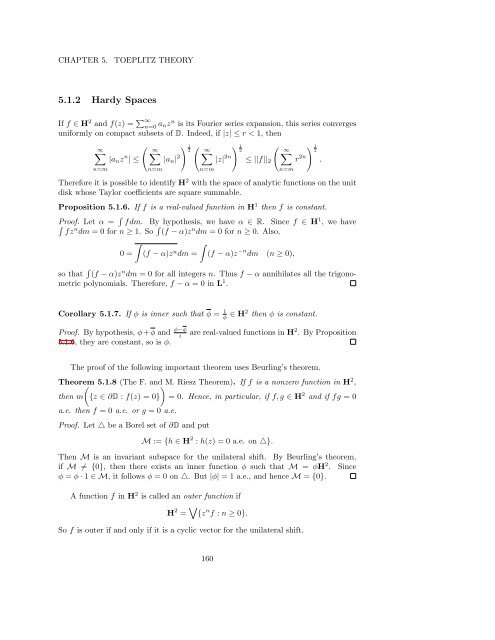Woo Young Lee Lecture Notes on Operator Theory
Woo Young Lee Lecture Notes on Operator Theory
Woo Young Lee Lecture Notes on Operator Theory
You also want an ePaper? Increase the reach of your titles
YUMPU automatically turns print PDFs into web optimized ePapers that Google loves.
CHAPTER 5.<br />
TOEPLITZ THEORY<br />
5.1.2 Hardy Spaces<br />
If f ∈ H 2 and f(z) = ∑ ∞<br />
n=0 a nz n is its Fourier series expansi<strong>on</strong>, this series c<strong>on</strong>verges<br />
uniformly <strong>on</strong> compact subsets of D. Indeed, if |z| ≤ r < 1, then<br />
(<br />
∞∑<br />
∑ ∞<br />
|a n z n | ≤<br />
n=m<br />
n=m<br />
|a n | 2 ) 1<br />
2 ( ∞ ∑<br />
n=m<br />
|z| 2n ) 1<br />
2<br />
≤ ||f|| 2<br />
( ∞<br />
∑<br />
n=m<br />
r 2n ) 1<br />
2<br />
.<br />
Therefore it is possible to identify H 2 with the space of analytic functi<strong>on</strong>s <strong>on</strong> the unit<br />
disk whose Taylor coefficients are square summable.<br />
Propositi<strong>on</strong> 5.1.6. If f is a real-valued functi<strong>on</strong> in H 1 then f is c<strong>on</strong>stant.<br />
Proof. Let α = ∫ fdm. By hypothesis, we have α ∈ R. Since f ∈ H 1 , we have<br />
∫<br />
fz n dm = 0 for n ≥ 1. So ∫ (f − α)z n dm = 0 for n ≥ 0. Also,<br />
∫<br />
0 =<br />
∫<br />
(f − α)z n dm =<br />
(f − α)z −n dm (n ≥ 0),<br />
so that ∫ (f − α)z n dm = 0 for all integers n. Thus f − α annihilates all the trig<strong>on</strong>ometric<br />
polynomials. Therefore, f − α = 0 in L 1 .<br />
Corollary 5.1.7. If ϕ is inner such that ϕ = 1 ϕ ∈ H2 then ϕ is c<strong>on</strong>stant.<br />
Proof. By hypothesis, ϕ+ϕ and ϕ−ϕ<br />
i<br />
5.1.6, they are c<strong>on</strong>stant, so is ϕ.<br />
are real-valued functi<strong>on</strong>s in H 2 . By Propositi<strong>on</strong><br />
The proof of the following important theorem uses Beurling’s theorem.<br />
Theorem ( 5.1.8 (The F. and)<br />
M. Riesz Theorem). If f is a n<strong>on</strong>zero functi<strong>on</strong> in H 2 ,<br />
then m {z ∈ ∂D : f(z) = 0} = 0. Hence, in particular, if f, g ∈ H 2 and if fg = 0<br />
a.e. then f = 0 a.e. or g = 0 a.e.<br />
Proof. Let △ be a Borel set of ∂D and put<br />
M := {h ∈ H 2 : h(z) = 0 a.e. <strong>on</strong> △}.<br />
Then M is an invariant subspace for the unilateral shift. By Beurling’s theorem,<br />
if M ̸= {0}, then there exists an inner functi<strong>on</strong> ϕ such that M = ϕH 2 . Since<br />
ϕ = ϕ · 1 ∈ M, it follows ϕ = 0 <strong>on</strong> △. But |ϕ| = 1 a.e., and hence M = {0}.<br />
A functi<strong>on</strong> f in H 2 is called an outer functi<strong>on</strong> if<br />
H 2 = ∨ {z n f : n ≥ 0}.<br />
So f is outer if and <strong>on</strong>ly if it is a cyclic vector for the unilateral shift.<br />
160













